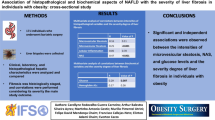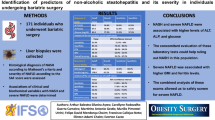Abstract
Background
In non-alcoholic fatty liver disease (NAFLD), steatosis can manifest through two distinct forms: macrovesicular (macroS) and microvesicular (microS).
Objective
To investigate the prevalence of microS and its association with biochemical parameters and NAFLD-related histological findings in individuals with obesity.
Methods
This is an observational retrospective cross-sectional study, enrolling individuals who underwent bariatric surgery and liver biopsy at a university hospital. A 1:2 propensity matching was performed to pair microS with isolated macroS; this matching enrolled variables “age,” “gender,” “body mass index (BMI),” and “obesity-associated medical problems.” Clinical, biochemical, and histopathological aspects were then analyzed and compared.
Results
Of 115 participants, 88.7% were female; average age was 40.5 ± 5 years and mean BMI was 37.9 ± 3.3 kg/m2. Steatosis occurred in 82.6% (67.8% isolated macroS and 14.8% microS). MicroS is significantly associated with higher levels of alanine aminotransferase (ALT) (39.8 ± 26.4 vs. 26.7 ± 17.5; p = 0.04) and glucose (103.8 ± 52.6 vs. 83.3 ± 10.8; p = 0.03) and higher frequencies of moderate to severe macroS (41.2% vs. 2.0%; p < 0.001), portal fibrosis (100% vs. 50%; p < 0.001), perisinusoidal fibrosis (100% vs. 55.9%; p < 0.001), lobular inflammation (100% vs. 41.1%; p < 0.001), and portal inflammation (100% vs. 41.1%; p < 0.001). An independently positive association was observed between intensities of microS and macroS (p < 0.001).
Conclusion
MicroS is significantly associated with higher levels of ALT and glucose and higher frequencies of moderate to severe macroS, hepatocellular ballooning, portal fibrosis, perisinusoidal fibrosis, lobular inflammation, and portal inflammation. These findings indicate that microS could be considered a reliable histological marker of NAFLD severity.
Graphical Abstract

Similar content being viewed by others
References
Kristiansen MNB, Veidal SS, Christoffersen C, et al. Molecular characterization of microvesicular and macrovesicular steatosis shows widespread differences in metabolic pathways. Lipids. 2019;54(1):109–15.
Celebi G, Cicek AF, Gurel H, et al. Microvesicular steatosis: a missed item in the management of nonalcoholic fatty liver disease? Acta Gastroenterol Belg. 2020;83(4):565–70.
Murag S, Ahmed A, Kim D. Recent epidemiology of nonalcoholic fatty liver disease. Gut Liver. 2021;15(2):206–16.
Tandra S, Yeh MM, Brunt EM, et al. Presence and significance of microvesicular steatosis in nonalcoholic fatty liver disease. J Hepatol. 2011;55(3):654–9.
Di Ciaula A, Passarella S, Shanmugam H, et al. Nonalcoholic fatty liver disease (NAFLD). Mitochondria as players and targets of therapies? Int J Mol Sci. 2021;22(10):5375.
Rinella ME. Nonalcoholic fatty liver disease: a systematic review. JAMA. 2015;313(22):2263–73.
Matthews DR, Hosker JP, Rudenski AS, et al. Homeostasis model assessment: insulin resistance and beta-cell function from fasting plasma glucose and insulin concentrations in man. Diabetologia. 1985;28(7):412–9.
Brunt EM, Kleiner DE, Wilson LA, et al. Nonalcoholic fatty liver disease (NAFLD) activity score and the histopathologic diagnosis in NAFLD: distinct clinicopathologic meanings. Hepatology. 2011;53(3):810–20.
Aly FZ, Kleiner DE. Update on fatty liver disease and steatohepatitis. Adv Anat Pathol. 2011;18(4):294–300.
Chalasani N, Wilson L, Kleiner DE, et al. Relationship of steatosis grade and zonal location to histological features of steatohepatitis in adult patients with non-alcoholic fatty liver disease. J Hepatol. 2008;48(5):829–34.
Boström P, Rutberg M, Ericsson J, et al. Cytosolic lipid droplets increase in size by microtubule-dependent complex formation. Arterioscler Thromb Vasc Biol. 2005;25(9):1945–51.
Martin S, Parton RG. Lipid droplets: a unified view of a dynamic organelle. Nat Rev Mol Cell Biol. 2006;7(5):373–8.
Matteoni CA, Younossi ZM, Gramlich T, et al. Nonalcoholic fatty liver disease: a spectrum of clinical and pathological severity. Gastroenterology. 1999;116(6):1413–9.
Powell EE, Cooksley WG, Hanson R, et al. The natural history of nonalcoholic steatohepatitis: a follow-up study of forty-two patients for up to 21 years. Hepatology. 1990;11(1):74–80.
Day CP, James OF. Hepatic steatosis: innocent bystander or guilty party? Hepatology. 1998;27(6):1463–6.
Fromenty B, Pessayre D. Inhibition of mitochondrial beta-oxidation as a mechanism of hepatotoxicity. Pharmacol Ther. 1995;67:101–54.
Sherlock S. Acute fatty liver of pregnancy and the microvesicular fat diseases. Gut. 1983;24:265–9.
Day CP, Yeaman SJ. The biochemistry of alcoholic fatty liver. Biochim Biophys Acta. 1994;1215:33–48.
Kreve F, Callejas GH, Jimenez LS, et al. Trajectory of NAFLD characteristics after Roux-en-Y gastric bypass: a five-year historical cohort study. Sao Paulo Med J. 2022;140(6):739–46.
Bower G, Toma T, Harling L, et al. Bariatric surgery and non-alcoholic fatty liver disease: a systematic review of liver biochemistry and histology. Obes Surg. 2015;25(12):2280–9.
Cazzo E, Pareja JC, Chaim EA. Nonalcoholic fatty liver disease and bariatric surgery: a comprehensive review. Sao Paulo Med J. 2017;135(3):277–95.
de Jesus RN, Callejas GH, Chaim FDM, et al. Roux-en-Y gastric bypass as a treatment for hepatic iron overload: an exploratory study. Obes Surg. 2022;32(7):2438–44.
Cazzo E, Jimenez LS, Pareja JC, et al. Effect of Roux-en-Y gastric bypass on nonalcoholic fatty liver disease evaluated through NAFLD fibrosis score: a prospective study. Obes Surg. 2015;25(6):982–5.
Sabench F, Bertran L, Vives M, et al. NASH presence is associated with a lower weight loss one and 2 years after bariatric surgery in women with severe obesity. Obes Surg. 2022;32(10):3313–23.
Rheinwalt KP, Drebber U, Schierwagen R, et al. Baseline presence of NAFLD predicts weight loss after gastric bypass surgery for morbid obesity. J Clin Med. 2020;9(11):3430.
Blume CA, Brust-Renck PG, Rocha MK, et al. Development and validation of a predictive model of success in bariatric surgery. Obes Surg. 2021;31(3):1030–7.
Author information
Authors and Affiliations
Corresponding author
Ethics declarations
Ethics Approval
All procedures performed in studies involving human participants were in accordance with the ethical standards of the institutional and/or national research committee and with the 1964 Helsinki declaration and its later amendments or comparable ethical standards.
Informed Consent
Informed consent was obtained from all individual participants included in the study.
Conflict of Interest
The authors declare no conflict of interest.
Additional information
Publisher's Note
Springer Nature remains neutral with regard to jurisdictional claims in published maps and institutional affiliations.
Work developed at Dept. of Surgery, School of Medical Sciences, State University of Campinas (UNICAMP), Campinas (SP), Brazil.
Key Points
1. Microvesicular steatosis associated with higher levels of alanine aminotransferase and glucose.
2. Microvesicular steatosis associated with histological hallmarks of non-alcoholic fatty liver disease (NAFLD) progression.
3. The presence of microvesicular steatosis could be considered a reliable histological marker of NAFLD severity in individuals with obesity.
Rights and permissions
Springer Nature or its licensor (e.g. a society or other partner) holds exclusive rights to this article under a publishing agreement with the author(s) or other rightsholder(s); author self-archiving of the accepted manuscript version of this article is solely governed by the terms of such publishing agreement and applicable law.
About this article
Cite this article
Germano, C.W., Mega, P.F., Mattosinho, T.J.A.P. et al. Microvesicular Steatosis in Individuals with Obesity: a Histological Marker of Non-alcoholic Fatty Liver Disease Severity. OBES SURG 33, 813–820 (2023). https://doi.org/10.1007/s11695-023-06467-9
Received:
Revised:
Accepted:
Published:
Issue Date:
DOI: https://doi.org/10.1007/s11695-023-06467-9




